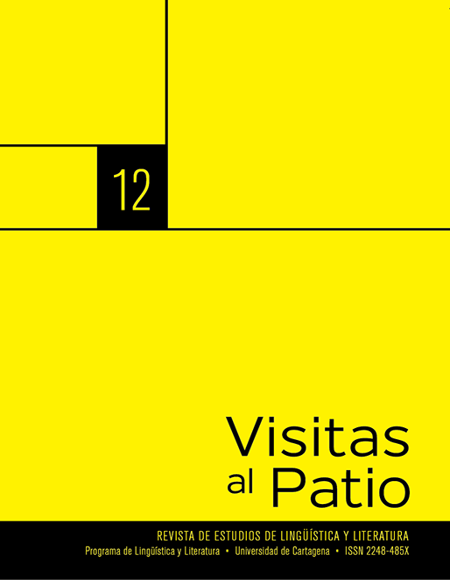Cuando la población migrante desmiente los discursos dominantes : autorretratos lingüístico-culturales de jóvenes hablantes bilingües del español en Suiza.
When migrants debunk dominant discourses : the linguistic and cultural self-portraits of young bilingual speakers of spanish in Switzerland.
Contenido principal del artículo
Resumen
Palabras clave:
Descargas
Detalles del artículo
Referencias (VER)
Augé, M. (2009). Pour une anthropologie de la mobilité. Paris : Payot & Rivages.
Bircher: (1998). Étrangers résidant en Suisse. Promotion d’une langue nationale. Berne : Le Parlement suisse. Revisado el 21 de mayo de 2018 desde Internet: https://www.parlament.ch/fr/ratsbetrieb/suche-curia-vista/geschaeft?AffairId=19983465
Blommaert, J. (2005). Discourse. Cambridge: Cambridge University Press. https://doi.org/10.1017/CBO9780511610295
Calvi, M. V. (2015). Etiquetas étnicas e identidad en entrevistas a inmigrantes hispanoamericanos en Italia. En: L. Mariottini (Ed.). Identità e discorsi. Studi offerti a Franca Orletti. (pp. 111-130). Roma: Roma TrE-Press.
De Flaugergues, A. (2016). Pratiques linguistiques en Suisse: premiers résultats de l’enquête sur la langue, la religion et la culture 2014. Neuchâtel: Office fédéral de la statistique. Revisado el 22 de mayo de 2018 desde Internet: https://www.bfs.admin.ch/bfs/fr/home/statistiques/population.assetdetail.1000171.html
Diez del Corral Areta, E. (por aparecer). Me siento muy poquititico suiza: identificación bilingüe y bicultural en inmigrantes colombianos de la Suiza francófona. Lengua y migración, 10, (2).
Duchêne, A., y Del Percio, A. (2014). Economic capitalization of linguistic diversity: Swiss multilingualism as a national profit? En: J. W. Unger, M. Krzyzanowski, y R. Wodak (Eds.). Multilingual encounters in Europe’s institutional spaces. (pp. 75-101). London et al.: Bloomsbury.
Fernández-Suárez, B. (2017). The design of migrant integration policies in Spain: discourses and social actors. Social Inclusion, 5(1), 117-125. https://doi.org/10.17645/si.v5i1.783
Flubacher, M. (2013). Language(s) as the key to integration? The ideological role of diglossia in the German-speaking region of Switzerland. En: E. Barát: Studer, y J. Nekvapil (Eds.). Ideological conceptualization of language: discourses of linguistic diversity. (pp. 171-192). Frankfurt am Main: Peter Lang.
García, O. (1993). From Goya portraits to Goya beans: elite traditions and popular streams in U.S. language policy. Southwest Journal of Linguistics, 12, 69-86.
Grosjean, F. (2008). The bicultural person: a short introduction. En: F. Grosjean (Ed.). Studying bilinguals. (pp. 213-220). Oxford y New York: Oxford University Press.
Hepburn, A., y Bolden, G. B. (2013). The conversation analytic approach to transcription. En: J. Sidnell y T. Stivers (Eds.). The handbook of conversation analysis. (pp. 57-76). Malden: Wiley-Blackwell. https://doi.org/10.1002/9781118325001.ch4
Hudson, A., Hernández-Chávez, E., y Bills, G. (1995). The many faces of language maintenance: Spanish language claiming in five Southwestern states. En: C. Silva-Corvalán (Ed.). Spanish in four continents: studies in language contact and bilingualism. (pp. 165-183). Washington, DC: Georgetown University Press.
Hymes, D. (1996). Ethnography, linguistics, narrative inequality: toward and understanding of voice. London: Taylor & Francis.
Irvine, J. T., y Gal, S. (2000). Language ideology and linguistic differentiation. En: P. Kroskrity (Ed.). Regimes of language. (pp. 35-83). Santa Fe: School of American Research Press.
Jefferson, G. (2004). Glossary of transcript symbols with an introduction. En: G. H. Lerner (Ed.). Conversation analysis: studies from the first generation. (pp.13-31). Amsterdam: John Benjamins. https://doi.org/10.1075/pbns.125.02jef
Johnstone, B. (2008). Discourse analysis. (2a ed.). Malden et al.: Blackwell. Ley Federal de Extranjería. (2005). Loi fédérale sur les étrangers (LEtr). Berne : Le Conseil fédéral. Revisado el 21 de mayo de 2018 desde Internet: https://www.admin.ch/opc/fr/classified-compilation/20020232/index.html
Liebscher, G., y Dailey-O’Cain, J. (2009). Language attitudes in interaction. Journal of Sociolinguistics, 13(2), 195-222. https://doi.org/10.1111/j.1467-9841.2009.00404.x
Lüdi, G., y Werlen, I. (2005). Le paysage linguistique en Suisse. Neuchâtel: Office fédéral de la statistique. Revisado el 22 de mayo de 2018 desde Internet: https://www.bfs.admin.ch/bfs/fr/home/statistiques/population/langues-religions/langues.assetdetail.342098.html
Porcel, J. (2006). The paradox of Spanish among Miami Cubans. Journal of Sociolinguistics, 10(1), 93-110. https://doi.org/10.1111/j.1360-6441.2006.00319.x
Rumbaut, R. G. (2004). Ages, life stages, and generational cohorts: decomposing the immigrant first and second generations in the United States. International Migration Review, 38(3), 1160-1205. https://doi.org/10.1111/j.1747-7379.2004.tb00232.x
Sánchez, R. (2016). Edificando espacios comunicativo-identitarios. Términos de autoidentificación en la prensa hispanófona neoyorquina durante la primera mitad del siglo XX. En: Y. Bürki y H. Partzsch (Eds.). Redes de comunicación: estudios sobre la prensa en el mundo hispanohablante. (pp. 249-279). Berlin: Frank & Timme.
Schwartz, S. J., y Unger, J. B. (2010). Biculturalism and context: what is biculturalism and when is it adaptive? Human Development, 53(1), 26-32. https://doi.org/10.1159/000268137
Toribio, A. J. (2011). Spanish English code-switching among US Latinos. International Journal of the Sociology of Language, 158, 89-119.
Wessendorf, S. (2013). Second-generation transnationalism and roots migration: cross-border lives. London y New York: Routledge.
Yeung, S. (2016). From cultural distance to skills and deficits: “expatriates,” “migrants” and Swiss integration policy. Multilingua, 35(6), 723-746. https://doi.org/10.1515/multi-2015-0074
Zentella, A. C. (1997). Growing up bilingual: Puerto Rican children in New York. Oxford: Blackwell.
Zentella, A. C. (2003). “José, can you see?”: Latin@ responses to racist discourse. En: D. Sommer (Ed.). Bilingual games: some literary investigations. (pp. 51-66). New York y Basingstoke: Palgrave. https://doi.org/10.1057/9781403982704_4



 PDF
PDF
 FLIP
FLIP





